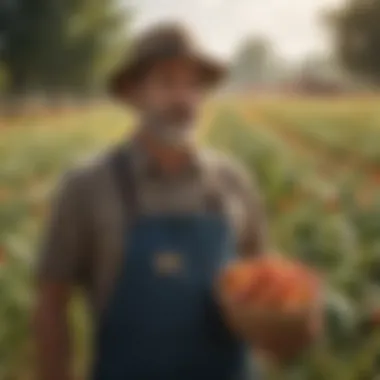The Old Fashioned Delivery: Traditional Agricultural Practices


Intro
The discussion of agricultural practices often oscillates between modern technologies and traditional methodologies. In examining the journey of agriculture, we find that old fashioned delivery forms a crucial bedrock for sustainable practices today. This article explores various aspects that shape traditional agricultural methods, their importance, and how they can coexist with contemporary practices.
Topic Overview
Definition and Importance
Old fashioned delivery refers to the traditional ways farmers have managed land and crops before the era of modern industrial farming. It encompasses not just methods of cultivation but also cultural knowledge passed down through generations. The importance of these practices lies in their ability to promote biodiversity, maintain soil health, and support local economies. They stand as a testament to an enduring understanding of the land and resources, emphasizing resilience and sustainability.
Brief History and Evolution
Historically, agricultural practices evolved out of necessity. In ancient civilizations, farmers relied on hand tools and animal power, enabling them to cultivate crops like wheat and barley. Over centuries, techniques were refined through trial and error, adapting to environmental conditions. With the advent of industrialization in the 18th century, many of these traditional practices faded. Yet, in recent times, there has been a resurgence in interest in these methods, often tied to movements advocating for eco-friendly practices and local food systems.
Key Techniques and Innovations
Sustainable Farming Practices
Sustainable farming practices stem from traditional methods but are updated with modern insights. These include crop rotation, which not only aids in maintaining soil fertility but also helps control pests and diseases without synthetic chemicals. Also, agroforestry represents another method where trees and crops are grown together. This can enhance biodiversity, improve soil structure, and create healthier ecosystems.
Advanced Agronomic Technologies
Despite this focus on traditional techniques, integrating advanced agronomic technologies can enhance the effectiveness of old methods. For instance, precision agriculture utilizes data analysis alongside traditional knowledge. The application of sensors and GPS technology helps farmers make informed decisions about planting and applying nutrients more efficiently. This synergy can lead to higher yields while preserving the integrity of traditional practices.
Practical Applications
Step-by-Step Guides
- Identifying Sustainable Methods: Understand local soil and crop conditions. Research traditional species that perform well in your region.
- Implementing Crop Rotation: Plan a rotation schedule for crops. This not only enriches the soil but also minimizes pest populations.
- Engaging in Local Markets: Establish relationships with local consumers. This can provide financial support for traditional practices, encouraging their continuation.
Case Studies or Real-World Examples
Case Study: Roger's Family Farm in Vermont uses old fashioned delivery techniques like crop rotation and organic fertilization. They have maintained healthy soil and achieved resilience against climate variability. Their success illustrates how traditional methods can lead to sustainable outcomes even in the face of modern challenges.
"In embracing old fashioned delivery, we reconnect with our roots, realizing that the wisdom of the past can illuminate better paths for the future."
By understanding and utilizing these historical practices, farmers can achieve a balance between innovation and tradition, further solidifying their role in sustainable agriculture.
Intro to Traditional Agricultural Delivery
Traditional agricultural delivery refers to the methods and systems used for distributing produce that rely on historical practices rather than modern mechanized models. This topic is significant because it offers insights into the resilience and adaptability of farming systems that have evolved over centuries. Many of these methods prioritize local knowledge and environmental stewardship, emphasizing sustainability and community engagement.
In this article, we will explore the various aspects of traditional agricultural delivery, examining the benefits it brings to local economies and ecosystems. Understanding these practices can be crucial for modern agricultural practitioners. As farming faces numerous challenges today, including climate change and market pressures, revisiting traditional methods may offer solutions that are both practical and sustainable.
Benefits of recognizing and implementing traditional agricultural practices include:
- Community Involvement: Traditional methods often involve local communities in the farming process, fostering social cohesion and shared responsibility for food production.
- Environmental Sustainability: Many old-fashioned techniques minimize environmental impact, promoting biodiversity and soil health.
- Cultural Heritage: These practices can strengthen cultural identity and preserve knowledge passed down through generations.
While advancements in technology have transformed agriculture, exploring the old-fashioned approaches provides a nuanced understanding of their potential relevance today. Using these practices with modern techniques might create a diverse and resilient agricultural system.
"In a world of ever-increasing industrialization, the value of traditional agricultural delivery systems cannot be underestimated. They not only enhance the quality of life for local communities but ensure food security for future generations."
By considering traditional agricultural delivery methods, this article aims to supply a thorough comprehension of how they can coexist with contemporary practices, thereby offering tangible benefits for both farmers and the wider environment.
Defining Old Fashioned Delivery in Agriculture
In the context of agriculture, "old fashioned delivery" refers to traditional methods of farming and crop distribution that have stood the test of time. The importance of defining this concept lies in understanding how these practices offer sustainable solutions in a rapidly changing world. Traditional agricultural practices focus on local knowledge, community collaboration, and ecological balance, which stand in contrast to industrial methods that prioritize high yields at the expense of the environment.
Characteristically, old fashioned delivery employs techniques that are adaptive and sensitive to the local environment. Farmers often rely on organic inputs, such as compost or animal manure, to enrich soil fertility. These methods also embrace crop rotation and companion planting, which enhance biodiversity and soil health. By maintaining ecological balance, farmers can produce food while preserving the landscape.
The benefits of these traditional approaches are manifold:
- They foster resilience in the face of climate change, ensuring food security.
- They emphasize a diverse range of crops that can offer nutritional benefits beyond that of monocultures.
- They often require fewer external inputs, thereby reducing costs and dependency on marketplaces.
Despite these advantages, it is essential to acknowledge considerations surrounding old fashioned delivery. While these practices promote sustainability, they may also face challenges related to market pressures and changing consumer preferences. Many modern consumers prioritize convenience and uniformity in produce, which often favors industrialized farming methods.
"Traditional agriculture is not a relic of the past; it is a viable model for the future of food security and environmental stewardship."
In summary, defining old fashioned delivery encompasses a critique of contemporary practices and an appreciation of the wisdom embedded in traditional methods. Understanding this term is crucial for exploring the broader implications of sustainable agriculture and fostering a sense of community among farmers and consumers. By recognizing these values, we can better appreciate the role of traditional methods in ensuring food justice, ecological balance, and cultural heritage in farming.


A Historical Overview of Traditional Farming Methods
Understanding the historical context of traditional farming methods provides valuable insights into agricultural practices today. This overview offers a glimpse into how ancient civilizations shaped agriculture and evolution of farming techniques through the centuries. The significance of this historical perspective lies in its ability to inform current agricultural practices and sustainability efforts. By learning from the past, modern agriculturalists can appreciate the wisdom embedded in these age-old methods.
Agricultural Practices in Ancient Civilizations
Agricultural practices date back thousands of years. Ancient civilizations, such as the Egyptians, Mesopotamians, and Chinese, laid the groundwork for farming as we know it today. The Egyptians utilized the annual flooding of the Nile River to irrigate their crops, demonstrating early techniques in water management. Similarly, the Mesopotamians developed complex irrigation systems. The methods employed by these civilizations were not simply survival tactics; they were finely tuned systems that integrated environmental observations with human ingenuity.
These ancient practices included sowing crops in specific patterns and using crop rotation to increase soil fertility. The focus on local climate and land features allowed these civilizations to maximize yields, ensuring food security for their communities. Understanding these concepts is crucial for today’s farmers as they navigate modern challenges such as soil degradation and climate variability.
"The past offers key lessons for navigating the complexities of contemporary agriculture."
Evolution of Farming Techniques Over Centuries
As societies grew and changed, agriculture evolved in tandem. From the simple hoe to the introduction of plows in various parts of the world, the methods of cultivation became more sophisticated. In Europe, the Middle Ages saw an increase in the application of technologies such as the heavy plow and the three-field crop rotation system. This shift did not occur overnight; it was the result of trial, error, and the gradual accumulation of knowledge.
The Industrial Revolution marked another significant turning point in agricultural history. Mechanization transformed traditional farming, allowing for higher productivity. However, this era also began to erode the reliance on sustainable practices rooted in centuries of experience. As a greater emphasis was placed on efficiency and output, the lessons learned from ancient and medieval techniques appeared to fade.
Today, there is a renewed interest in reclaiming some of these ancient practices, particularly organic farming and permaculture. They offer sustainable solutions that address current environmental challenges. The evolution of farming techniques shows a pendulum swing between innovation and tradition, and this interplay is crucial for understanding contemporary agricultural strategies.
Key Components of Old Fashioned Delivery
Understanding the key components of old fashioned delivery in agriculture allows us to appreciate the depth and resilience of traditional practices. These practices have evolved over generations, integrating the wisdom of local communities and the nuances of specific environments. Two fundamental components stand out: crop selection based on local knowledge and the utilization of organic methods and inputs. Each of these elements contributes significantly not just to farming efficacy, but also to the sustainability and health of local ecosystems.
Crop Selection Based on Local Knowledge
The practice of selecting crops based on local knowledge is vital. Local farmers often possess deep insights into the soil types, climate conditions, and pest behaviors unique to their regions. This intimate knowledge enables them to choose crops that are best suited to their local environment, maximizing yields while minimizing risks.
For example, in regions with variable rainfall, farmers might select drought-resistant varieties that require less water. Similarly, in areas with specific pest issues, they can choose crop varieties that are more resistant to those pests. This approach not only supports the longevity of farming practices but also enhances biodiversity, thereby contributing to healthier ecosystems. The interaction between crops and local environment is a delicate balance that many traditional farmers navigate expertly.
Additionally, these practices often include traditional planting schedules based on phenological events. Such wisdom reflects a relationship cultivated over centuries.
Utilization of Organic Methods and Inputs
Another key aspect of old fashioned delivery is the utilization of organic methods and inputs. Traditional agriculture frequently employs natural fertilizers and pest control strategies, which are less harmful to the environment compared to many modern fertilizers and chemicals.
Organic methods include using compost, crop rotation, and polyculture. Each of these practices helps maintain soil fertility, improve biodiversity, and prevent soil erosion. By avoiding synthetic chemicals, farmers preserve soil health and protect the surrounding ecosystems.
Moreover, organic inputs contribute to sustainable agriculture. They keep production in harmony with the environment, thus reducing the carbon footprint associated with farming activities. In doing so, old fashioned delivery aligns well with contemporary sustainability goals.
"The integration of organic practices within traditional agricultural methods not only enhances productivity but also safeguards environmental health."
Comparing Old and New Agricultural Practices
The examination of old and new agricultural practices is essential for understanding the broader implications on farming today. Traditional methods, often termed "old-fashioned delivery," have formed the foundation of agricultural systems worldwide. They provide insights into sustainable farming, community resilience, and ecological balance. In contrast, modern techniques, driven by technological advancements and industrialization, have reshaped how farming is carried out. This section investigates these two paradigms, focusing on their unique attributes, benefits, and challenges.
Technological Advancements in Agriculture
Technology has dramatically altered the agricultural landscape. The introduction of machinery, such as tractors and automated harvesters, has increased efficiency and output. These advancements allow farmers to cultivate larger areas in shorter periods, reshaping the economic viability of farming operations. However, this rapid growth raises concerns. For instance, the dependency on machines can lead to diminishing labor roles within farming communities. This shift can alter social dynamics, as workers may find fewer opportunities in traditional agricultural settings.
Furthermore, precision agriculture represents another technological advancement. By utilizing GPS and data analytics, farmers can make informed decisions about resource allocation, soil management, and crop rotations. This can minimize waste and improve yields. Yet, the reliance on high-tech solutions often necessitates significant investments, which may not be accessible to all farmers.
Sustainability: Traditional Techniques vs. Modern Approaches
Sustainability is a primary concern in agriculture today. Traditional farming methods typically emphasize soil conservation, crop diversity, and use of local resources. These practices promote biodiversity, which is critical in fostering resilience against pests and diseases. For example, rotating crops and planting cover crops ensure nutrient-rich soil and minimize erosion, which contributes to more sustainable ecosystems.
In sharp contrast, modern practices may lead to soil depletion and habitat loss. The heavy use of synthetic fertilizers and pesticides promises increased production but often results in long-term ecological damage. There is a growing awareness among modern farmers of these issues, leading to a blending of old and new techniques. Many now adopt integrated pest management strategies or organic certification, which align more closely with traditional ideals.
"Integrating the wisdom of traditional practices with cutting-edge technologies can pave the way for a more sustainable agricultural future."
This exploration enables farmers and agricultural enthusiasts to assess their practices critically. By understanding the strengths and weaknesses of both traditional and modern methods, practitioners can make informed choices that benefit their farms and the environment.
The Role of Old Fashioned Delivery in Sustainable Agriculture
Sustainable agriculture seeks to meet our present food needs without compromising future generations. In this context, old fashioned delivery plays a significant role. Traditional practices often emphasize biodiversity, ethical land use, and community engagement. These elements directly support sustainability by fostering resilience within agricultural systems.
One critical aspect of old fashioned delivery is its focus on local ecosystems. Traditional methods often involve the intricate knowledge of local flora and fauna. Farmers who rely on old practices tend to select crops that are suited to their environment. This not only enhances yield but also reduces the need for chemical inputs.
Additionally, crop rotation is a common feature in traditional systems. This technique helps maintain soil fertility and control pests naturally. Modern farming can overlook such methods, leading to soil depletion and increased reliance on fertilizers and pesticides. By contrast, integrating these traditional practices can boost overall ecosystem health.
Benefits of Integrating Traditional Methods


- Biodiversity Preservation: Old practices frequently promote a diverse range of crops. This biodiversity can protect against crop failure due to diseases or extreme weather, helping to stabilize food supply.
- Soil Health Enhancement: Traditional practices prioritize organic matter and cover crops, which improve soil structure and health. Healthier soils lead to better water retention and nutrient availability.
- Cultural Significance: Traditional agricultural methods often imbue deep cultural and communal ties. Supporting these practices helps preserve heritage while also creating local jobs and reinforcing community structures.
Some might argue that old fashioned delivery systems can be inefficient compared to modern techniques. However, the effectiveness of these methods shines in their alignment with sustainable principles. These practices not only fulfill immediate agricultural needs but also lay the groundwork for long-term environmental stability.
"Sustainable agriculture is not just about food production; it's about nurturing the land and community for future generations."
In this way, the fusion of old fashioned delivery with modern methods can yield a more robust agricultural framework. The symbiosis between tradition and innovation can create a path forward. It's evident that exploring old practices within today’s context offers valuable insight into achieving sustainability.
As the world grapples with climate change and environmental degradation, recalling these traditional approaches might be key to fostering a sustainable future in agriculture.
Case Studies: Success Stories in Traditional Delivery
Exploring case studies in traditional agricultural methods reveals essential insights into how these practices not only endure but also thrive in modern contexts. Such examples highlight the effectiveness of old fashioned delivery systems and their ability to contribute positively to farming communities. This section will present significant elements that establish successful outcomes within traditional frameworks, showcasing the benefits and positive social impacts that arise from these case studies.
Successful Traditional Farms: Lessons Learned
Successful traditional farms often serve as beacons of knowledge, guiding us through strategies that blend ancient wisdom with modern needs. These farms utilize localized approaches that prioritize biodiversity and soil health without relying heavily on chemical fertilizers or pesticides. The lessons derived from these farms can be summarized as follows:
- Crop Rotation and Diversity: Many successful traditional farms practice crop rotation. This enhances soil fertility and reduces pest populations naturally.
- Community Engagement: Local farms often involve community members in decision-making processes. This fosters a sense of ownership and responsibility towards sustainable practices.
- Resilience to Change: Traditional farms show a remarkable ability to adapt. For instance, many farmers have integrated new knowledge about organic methods while retaining traditional techniques.
These farms not only produce food but also maintain biodiversity and strengthen community ties. A strong example of this can be seen in the practice of intercropping, where farmers grow two or more crops in proximity. This method does not just optimize space but also enhances crop yields and nutrient availability.
Community Farming Initiatives
Community farming initiatives are an essential aspect of old fashioned delivery systems and play a significant role in promoting sustainable agricultural practices. These initiatives typically focus on local involvement, sharing resources and knowledge among farmers. Effective community farming can lead to several positive outcomes:
- Education and Knowledge Sharing: Local farming groups often host workshops and training sessions. This promotes knowledge transfer about traditional farming techniques that have stood the test of time.
- Economic Benefits: By working together, farmers can reduce costs and increase income through cooperative buying and selling. This method enhances local economies and provides fairer prices for produce.
- Sustainability: These initiatives often emphasize sustainable practices, such as organic farming. This not only restores soil health but also reduces environmental degradation.
Ultimately, community farming initiatives foster a network of support that enhances both social and economic resilience. These examples underscore the multifaceted nature of traditional delivery, illustrating how these practices evolve and remain relevant.
"In the heart of community farming lies the spirit of collaboration which revitalizes agricultural practices while enhancing the socio-economic fabric of local areas."
Challenges Faced by Traditional Delivery Systems
Traditional agricultural practices, while rich in history and cultural significance, face numerous challenges in the current landscape. Understanding these challenges is crucial, as they impact both the sustainability of these methods and their viability in a fast-evolving agricultural environment. This section delves into two primary challenges: marketplace pressures and climate change impacts.
Marketplace Pressures
Traditional agricultural delivery systems often struggle against modern marketplace dynamics. Farmers relying on old fashioned practices find themselves squeezed by large-scale agricultural enterprises that leverage industrial methods to offer lower prices. This price competition can undermine the livelihoods of traditional farmers, who may not have the capacity to scale up production or reduce costs without sacrificing quality.
Additionally, changing consumer preferences complicate the scenario. Many consumers are drawn to convenience and uniformity offered by industrialized agriculture. As a result, products sourced from traditional methods may not always align with current market demands. This shift can lead to a decline in market opportunities for farmers who emphasize local, organic, or heritage crops. Factors such as these create significant hurdles for traditional delivery systems.
Climate Change Impacts
The effects of climate change represent another pressing challenge for traditional agriculture. Shifting weather patterns can drastically affect crop yields and biodiversity. Many old fashioned practices depend on seasonal cycles and specific climate conditions, which are becoming increasingly unpredictable due to global warming. For instance, farmers may face earlier springs or prolonged droughts, disrupting planting and harvesting schedules.
Moreover, traditional methods often rely on diverse cropping systems. With climate change threatening biodiversity, traditional farms risk losing vital seeds and techniques that have been cultivated for generations. This loss not only impacts food security but also jeopardizes cultural heritage associated with those agricultural practices.
In summary, traditional delivery systems encounter an array of challenges that threaten their existence. A nuanced understanding of marketplace pressures and climate change impacts reveals the complexity of maintaining these practices in today’s world and highlights the need for innovative solutions and adaptive strategies.
Integrating Old Fashioned Delivery with Modern Techniques
The need to integrate old fashioned delivery with modern techniques lies at the heart of revitalizing agriculture today. Traditional practices often reflect a deep understanding of local ecosystems, which is invaluable in addressing modern agricultural challenges. While increased industrialization has brought advancements, it often neglects the lessons learned from centuries of agricultural wisdom. By merging these two approaches, agriculture can benefit in various forms.
Benefits of Integration
- Improved Yield and Quality: Combines the robust crop selection from traditional methods with modern farming innovations like precision agriculture. This enhances both yield and quality.
- Resource Efficiency: Traditional practices usually prioritize local resources and minimize waste. When integrated with modern methods, these practices can lead to more effective use of inputs.
- Resilience to Climate Change: Traditional methods often incorporate practices like crop rotation and intercropping, which provide greater resilience in the face of climate change impacts.
Considerations in Integration
- Cultural Sensitivity: Understanding local customs is crucial. This ensures that modern techniques do not displace or conflict with traditional farming values.
- Accessibility to Technology: Farmers in rural areas may not have access to the latest technologies. Thus, introducing new tools requires training and resources to be viable.
Integrating old and new techniques can create a harmonious balance benefiting farmers, communities, and the environment.
Ultimately, the successful blend of old fashioned delivery with modern techniques can lead to a more sustainable agricultural future. It fosters not only productivity but also a deeper connection to the land and communities.
Hybrid Farming Models
Hybrid farming models are an optimal way to merge traditional and modern agricultural practices. These models integrate the strengths of both approaches while mitigating weaknesses. Farmers may adopt sustainable practices like organic inputs alongside modern techniques such as data analytics to enhance farming decisions. This results in higher productivity while preserving ecological balance.


Examples of Hybrid Techniques
- Agroforestry: This method incorporates trees and shrubs into farmland, enhancing biodiversity while maximizing crop productivity.
- Mixed Cropping: Combining multiple crops can yield better results than monoculture systems, which are traditionally modern.
Knowledge Exchange and Education
Knowledge exchange is vital for harnessing the best of both worlds. Education programs that connect veteran farmers with newcomers can be transformative. They facilitate skill sharing and adaptation of traditional methods infused with modern technology.
Key Strategies
- Workshops and Training: Provide hands-on training in both traditional practices and technological tools.
- Mentorship Programs: Pairing experienced farmers with novices can promote the practical application of integrated methods.
Research shows that farms that engage in knowledge exchange are often more successful in adapting to challenges while maximizing yield. Traditional practices hold a treasure trove of agricultural knowledge, and by educating a new generation, we ensure these insights are not lost.
Global Perspectives on Traditional Agriculture
The significance of exploring global perspectives on traditional agriculture lies in recognizing the diverse practices that have evolved over centuries. Each culture harbors unique methods that reflect its environment, history, and social structures. This section aims to uncover the richness of these practices and their contributions to sustainable agriculture.
Traditional agricultural methods are often closely tied to local ecosystems. They embody knowledge that has been passed down through generations, allowing communities to adapt to specific climatic and geographical conditions. For instance, rice farming in Southeast Asia showcases how water management techniques align with regional climate patterns, offering insights into sustainable practices. Farmers in these regions have developed intricate irrigation systems that maximize water use efficiency and minimize waste.
Traditional Practices in Various Cultures
Diverse cultures have developed distinct farming practices based on their environmental contexts. Here are a few notable examples:
- Andean Agriculture: Farmers in the Andes utilize terracing to cultivate crops on steep slopes, optimizing sunlight exposure and water retention.
- Sahelian Pastoralism: In the Sahel region of Africa, mobile pastoralism allows herders to move with their livestock to find fresh pastures, promoting land regeneration and sustainability.
- Rice Cultivation in Asia: In countries like Vietnam and Thailand, traditional wet rice farming is not just a method of food production but also involves a rich cultural heritage celebrated through festivals.
Each of these practices emphasizes a deep understanding of local resources and resilience in the face of environmental challenges.
Lessons from Indigenous Farming Methods
Indigenous farming methods offer valuable lessons for contemporary agricultural practices. They illustrate the balance between productivity and environmental stewardship. These methods often prioritize biodiversity and soil health. For example:
- Agroforestry: Many indigenous communities integrate trees with crops, enhancing biodiversity and improving soil quality.
- Crop Diversity: Cultivating a variety of crops mitigates risks associated with climate variability and pest outbreaks.
- Community Knowledge: The use of traditional ecological knowledge allows for effective resource management, ensuring sustainable yields without depleting the ecosystem.
"Understanding and embracing traditional agricultural practices is a key step toward sustainable food systems globally."
For further reading on traditional agriculture practices, visit Wikipedia or explore articles on Britannica.
The Future of Old Fashioned Delivery
The future of old fashioned delivery in agriculture holds profound significance. Amidst an evolving agrarian landscape, traditional methods of farming are proving to be not just relics of the past but valuable philosophies that can guide sustainable practices in contemporary agriculture. As industrialization presses forward, the integration of old practices with modern technology may unlock myriad benefits. Embracing these traditional techniques can lead to a rounded approach to farming, addressing both ecological concerns and economic stability.
Prospects in an Increasingly Industrialized World
In an age where industrial agriculture dominates, many farmers face a conflict between the efficiency of large-scale production and the need for sustainability. Traditional agricultural practices, characterized by a slower pace and more conscientious use of resources, present a viable path forward.
One major advantage is the adaptability of old fashioned methods in local contexts. Farmers can select crops based on regional climate and soil types, fostering biodiversity and resilience. Furthermore, these practices can mitigate the negative effects of monoculture, which is often seen in modern farming.
The focus on local markets also brings economic advantages. It allows farmers to connect with community needs, enhancing relationships with consumers and reducing wastage through more tailored production.
Overall, adopting elements of traditional delivery in such a rapidly industrializing world can create a balance between productivity and sustainability.
Emerging Trends and Innovations
While traditional methods may seem simplistic, new trends are emerging that blend these time-honored practices with modern agricultural innovations. One significant trend involves precision agriculture, which uses data and technology to improve crop management. This can be harmoniously integrated with old fashioned delivery methods, enhancing yields while maintaining a focus on soil health.
Additionally, agroecology is gaining traction, promoting systems that emulate natural ecological processes. This approach draws on traditional farming wisdom, emphasizing crop diversity and natural pest control. Consequently, practices like intercropping and crop rotation are being recognized for their benefits in pest management and soil nutrient replenishment.
Innovations such as the use of drones for monitoring crop health and soil conditions can be employed alongside traditional methods to bolster farmer decision-making. This merging of techniques promises to enhance productivity without sacrificing the environment.
The future of old fashioned delivery lies not in its rejection but in its revitalization through modern practices.
Closure: The Enduring Value of Traditional Practices
The exploration of traditional agricultural practices reveals significant insights into their continued relevance in the modern agricultural landscape. This conclusion aims to encapsulate the key findings of this narrative, highlighting the enduring value of these methods through various lenses.
At the intersection of sustainability and socio-economic development, traditional practices offer a holistic framework that modern agribusiness can learn from. These methodologies are not merely remnants of a bygone era; they are vital components that contribute to the resilience of food systems.
Key Elements of Traditional Practices
Traditional agricultural practices involve techniques passed down through generations. These methods emphasize local knowledge, crop diversity, and community involvement. Such practices often lead to sustainable results as they minimize environmental impact. For example, organic farming methods and permaculture principles demonstrate a commitment to soil health and biodiversity. Understanding these principles can inspire contemporary practices that prioritize sustainability over mere productivity.
Benefits of Embracing Old Fashioned Delivery
- Biodiversity Enhancement: Traditional agriculture encourages a wide variety of crops and livestock. This diversity not only strengthens local ecosystems but also provides food security and agricultural resilience.
- Cultural Heritage: These practices preserve cultural identities and community ties, fostering an appreciation for local food systems.
- Cost Efficiency: By utilizing locally available resources and materials, traditional methods can be more cost-effective compared to industrial farming techniques.
- Soil Conservation: Many traditional practices focus on maintaining soil fertility through crop rotation and natural composting, leading to long-term agricultural productivity.
Considerations for the Future
While the benefits of traditional agricultural practices are undeniable, it is equally important to consider their integration with modern techniques. This synthesis can enhance productivity while addressing contemporary issues like climate change and food scarcity. The lessons learned from traditional practices can contribute significantly to developing sustainable farming models.
In summary, the investigation into traditional agricultural practices shows that their value is immense and multifaceted. These methods not only serve as sustainable alternatives but also promote social and economic stability in farming communities. Reinvigorating these practices in conjunction with modern innovations can pave the way for a resilient and prosperous agricultural future.



